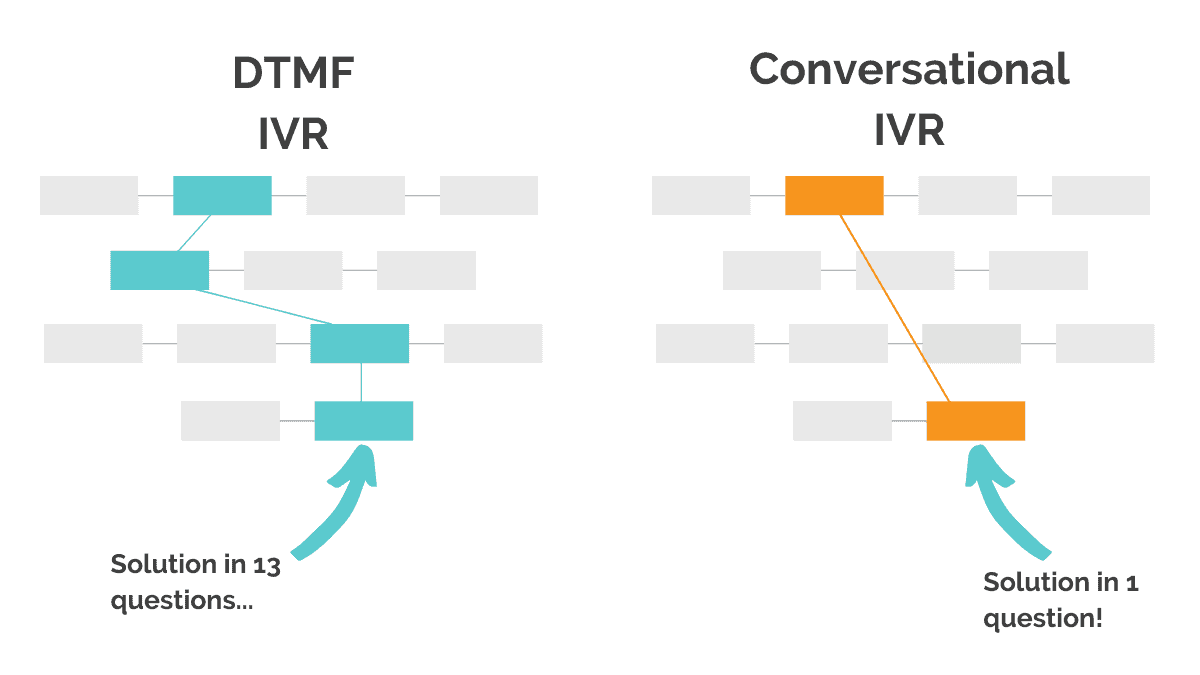Post summary:
- Conversational IVR will be the biggest use for Natural Language Understanding. But the tech also has valuable uses for agent productivity.
- New automation is decreasing call volume – but agents will handle more complex calls as a result.
- The role that agents fill will shift drastically as NLU becomes universal. Now is the time to start redesigning recruitment and training processes.

There’s growing hype around Natural Language Understanding (NLU).
Quite rightly! Like most businesses, we’ve mainly focused on conversational IVR service so far.
And sure, why not! Conversational IVR is already turning the customer service landscape upside down.
But that’s not the only trick NLU can do…
Today we’re going to look at the other ways to apply NLU to your service.
It’s time for a special focus on agent productivity and wellbeing!
Refresher: what is NLU?
NLU is the ability of an automated system to understand what a customer wants based on what they say.
This tech is an important subset of Natural Language Processing (NLP) which determines what words a customer is using.
So you can think about it as two stages:
- NLP – what is the customer saying?
- NLU – based on that, what does the customer want?
(If you’re looking for more detail, read our post: ‘NLP and NLU – IVR technologies defined!’)
3 Extra NLU benefits for contact center agents
New call center technologies aren’t always a clear win-win for everyone.
But once you start putting NLU into practice, your agents will quickly notice the ways it benefits them.
In fact, there’s every reason to think that your business, your customers and your staff will get something positive!
Here’s why…
#1 Capturing customer intent
Most of the time, you want your customers to use automation instead of reaching an agent.
But sometimes that’s not practical – some customers will use IVR and reach an agent.
Some customers will resist even the very best IVR technologies. (Although much less often.)
The key difference NLP can make is in the handover from IVR to agent.
Let’s imagine some scenarios…
A customer calls because their order hasn’t arrived. They want to know if there’s any update. If it’s lost, they’d rather have a refund instead of a replacement.
There are a few steps in that query, so the customer will probably need an agent.

Scenario 1: They go through a traditional IVR
What can that IVR learn about the reason for their call in an acceptable number of questions?
It’ll probably learn which team the customer wants to speak to. (sales, service etc.)
Perhaps it will learn that they’re calling about an existing order.
Finally, it’ll learn which order that was.
(I think three pathways is enough, don’t you?)
Now that customer reaches an agent.
Assuming it’s a well-integrated IVR – it passes the information forward – does the agent have a full understanding of the issue? I’d have to say no; they’ll need to ask more questions.
Let’s try again.
Scenario 2: They go through a conversational IVR.
What can the conversational IVR learn?
Well, all the customer needs to say is: my order hasn’t arrived. I’d like a refund.
The NLU component will easily pick out ‘my order’ and ‘refund’ as the important concepts.
Plus, if the system uses CTI it’s able to identify the customer – and therefore the delivery they’re talking about.
(Read: What is CTI?)
Now, if the IVR hands over to an agent, it hands over a transcript of this interaction and a tracking number for the order.
The agent has everything they need. They can dive straight into a resolution.
The best outcome for caller and agent
That’s obviously a smoother experience for the customer.
It’s also better for the agent because there’s little to no research required.
In a typical call, an agent spends just 25% of their time interacting with the customer. The rest is devoted to performing manual research!
That all changes when an integrated ‘listening’ system actually shares what it learns.
#2 Giving agents virtual assistance
Virtual assistants aren’t limited to helping customers. They can also do a lot to help agents, especially those who are still in training.
Take sales staff. It takes about ten months for a new salesperson to become fully productive. Can you bring that down to a couple of months?
Find upselling and cross-selling opportunities
One option is to take your NLU system and apply it to customer conversations with agents. Its role is to prompt agents to act on key selling opportunities.
How does it know what those selling opportunities are?
There are few ways. First, you can link products on an ‘if X, then Y’ basis. A simple example; if a customer’s buying a phone, do they need the warranty?
Or, you can lean on the machine learning at the heart of NLU.
When customers buy certain products, what else are they generally interested in?
If you think about it, that’s not any more complex than Amazon’s ‘customers who purchased this also liked…’
Improving the quality of your data
Sure, data hygiene is less eye-catching than upselling.
But data is what a contact center deals in, so… there’s really no excuse to ignore data quality!
If you need a compelling reason, here it is: IBM estimates that poor quality data costs businesses $3billion+ annually.
Businesses like yours!
There are plenty of small and affordable ways to combat this waste.
NLU systems can recognize when categories of data like phone numbers and addresses are discussed, prompting agents to confirm or update them.
Crucially, this prompt can be time-sensitive. If an address hasn’t been confirmed in the last two years, do it now. If it was confirmed a week ago, don’t bother.
The total effect of that diligence is a far greater degree of accuracy in your customer data.
These are the kinds of ideas contact centers often try to turn into agent processes. But it seldom works – agents already have too much competing for their attention.
‘Importantly, the benefits of improving data quality go far beyond reduced costs. It is hard to imagine any sort of future in data when so much is so bad. Thus, improving data quality is a gift that keeps giving — it enables you to take out costs permanently and to more easily pursue other data strategies.’
Thomas C. Redman, Harvard Business Review
Training agents in better processes
No contact center can completely remove complexity from its processes.
Over time, agents develop an amazing capacity to navigate those processes.
But it doesn’t hurt to help them out – especially new agents who can easily feel overwhelmed.
This is one of the strongest areas for virtual assistance.
With an NLU-based system navigating your knowledge base or customer records, agents get a shortcut to the right answers.
Think about it this way: when a customer asks a question, it will actually be an automated system providing the right information.
The agent’s role is to filter and interpret the best answer.
Do CTI Screen pops increase agent productivity and efficiency?
#3 Preventing avoidable contacts
We started this post talking about productivity – but we haven’t defined that word.
Productivity can be a misleading concept. You might look out across a sea of busy agents, all helping customers. All being productive.
But being productive doesn’t just mean being occupied!
Look at it like this; you could walk around the office picking lint off the carpet. You’d definitely be very occupied… but would you be productive?
No! Because a vacuum cleaner is better suited to the task.
It’s the same with agents and automation. An agent can spend a whole day resetting customers’ passwords. But that task should be automated!
It’s all about letting different resources play to their strengths.
For conversational IVR, that’s repetitive and high-volume queries.
For agents, that’s customer engagement and relationship building.
It’s time to fully professionalize the role of contact center agent. Most contact centers recruit agents based on people skills like communication and empathy.
But the actual work agents have to do is grindingly dull data entry, and answering the same small set of queries over and over.
The result is a record-low staff attrition!
‘It can also be damaging to call centre morale if the same queries are dealt with time and time again. This isn’t the greatest use of staff who have been trained to deal with a range of enquiries.
By automating these basic enquiries through a voice recognition system, fewer calls have to be transferred, staff can make better use of their training and – of course – waiting times for a call centre agent can be slashed.’
Mark Grainger, Finextra.com
Of course, this is just one of the questions that conversational IVR is going to raise for contact centers.
There’s no doubt that the tech is just a couple of years away from being mainstream – the default choice.
But making good use of NLU – either for conversational IVR or for agent productivity – needs a rigorous approach to automation.
Luckily, that’s our speciality!




